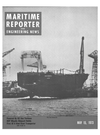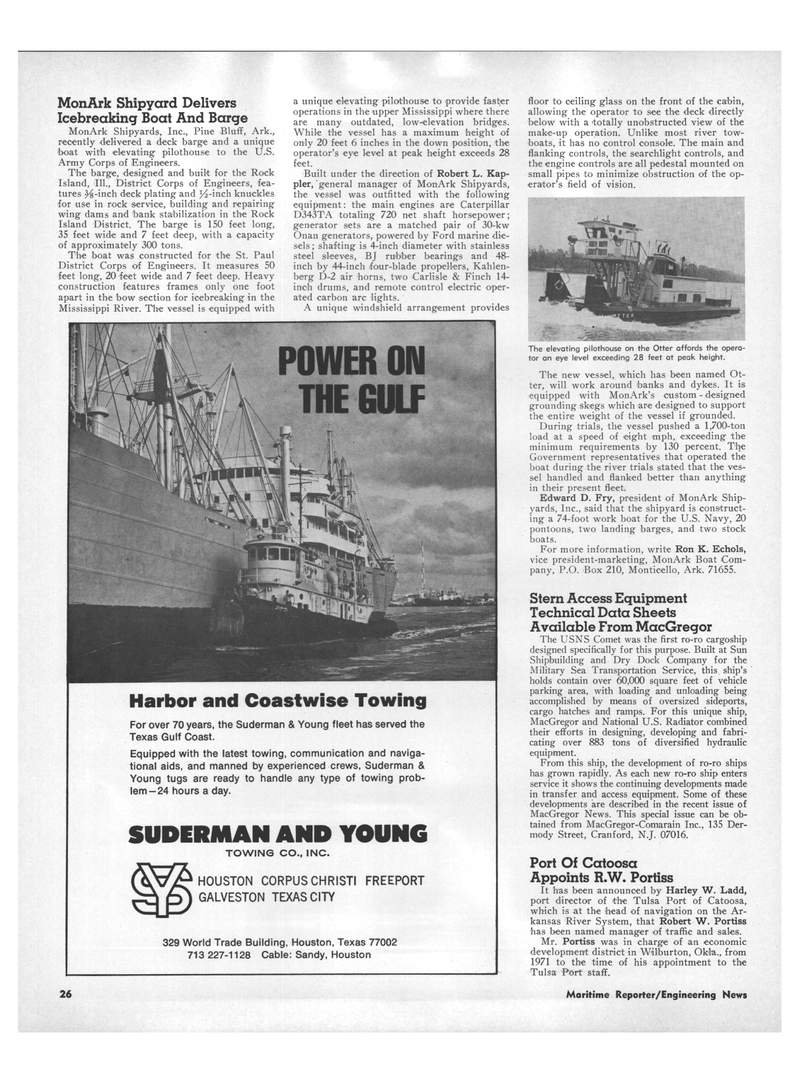
Page 24: of Maritime Reporter Magazine (May 15, 1973)
Read this page in Pdf, Flash or Html5 edition of May 15, 1973 Maritime Reporter Magazine
MonArk Shipyard Delivers
Icebreaking Boat And Barge
MonArk Shipyards, Inc., Pine Bluff, Ark., recently 'delivered a deck barge and a unique boat with elevating pilothouse to the U.S.
Army Corps of Engineers.
The barge, designed and built for the Rock
Island, 111., District Corps of Engineers, fea- tures -Hs-inch deck plating and J^-inch knuckles for use in rock service, building and repairing wing dams and bank stabilization in the Rock
Island District. The barge is 150 feet long, 35 feet wide and 7 feet deep, with a capacity of approximately 300 tons.
The boat was constructed for the St. Paul
District Corps of Engineers. It measures 50 feet long, 20 feet wide and 7 feet deep. Heavy construction features frames only one foot apart in the bow section for icebreaking in the
Mississippi River. The vessel is equipped with a unique elevating pilothouse to provide faster operations in the -upper Mississippi where there are many outdated, low-elevation bridges.
While the vessel has a maximum height of only 20 feet 6 inches in the down position, the operator's eye level at peak height exceeds 28 feet.
Built under the direction of Robert L. Kap- pler, "general manager of MonArk Shipyards, the vessel was outfitted with the following equipment: the main engines are Caterpillar
D343TA totaling 720 net shaft horsepower; generator sets are a matched pair of 30-kw
Onan generators, powered by Ford marine die- sels; shafting is 4-inch diameter with stainless steel sleeves, BJ rubber bearings and 48- inch by 44-inch four-blade propellers, Ka'hlen- berg D-2 air horns, two Carlisle & Finch 14- ineh drums, and remote control electric oper- ated carbon arc lights.
A unique windshield arrangement provides floor to ceiling glass on the front of the cabin, allowing the operator to see the deck directly below with a 'totally unobstructed view of the make-up operation. Unlike most river tow- boats, it has no control console. The main and flanking controls, the searchlight controls, and the engine controls are all pedestal mounted on small pipes to minimize obstruction of the op- erator's field of vision.
The elevating pilothouse on the Otter affords the opera- tor an eye level exceeding 28 feet at peak height.
The new vessel, which has been named Ot- ter, will work around banks and dykes. It is •equipped with MonArk's custom - designed grounding skegs which are designed to support the entire weight of the vessel if grounded.
During trials, the vessel pushed a 1,700-ton load at a speed of eight mph, exceeding the minimum requirements by 130 percent. The
Government representatives that operated the boat during the river trials stated that the ves- sel handled and flanked better than anything in their present fleet.
Edward D. Fry, president of MonArk Ship- yards, Inc., said that the shipyard is construct- ing a 74-foot work boat for the U.S. Navy, 20 pontoons, two landing barges, and two stock boats.
For more information, write Ron K. Echols, vice president-marketing, MonArk Boat Com- pany, P.O. Box 210, Monticello, Ark. 71655.
Stern Access Equipment
Technical Data Sheets
Available From MacGregor
The USNS Comet was the first ro-ro cargoship designed specifically for this purpose. Built at Sun
Shipbuilding and Dry Dock Company for the
Military Sea Transportation Service, this ship's holds contain over 60,000 square feet of vehicle parking area, with loading and unloading being accomplished by means of oversized sideports, cargo hatches and ramps. For this unique ship,
MacGregor and National U.S. Radiator combined their efforts in designing, developing and fabri- cating over 883 tons of diversified hydraulic equipment.
From this ship, the development of ro-ro ships has grown rapidly. As each new ro-ro ship enters service it shows the continuing developments made in transfer and access equipment. Some of these developments are described in the recent issue of
MacGregor News. This special issue can be ob- tained from MacGregor-Comarain Inc., 135 Der- mody Street, Cranford, N.J. 07016.
Port Of Catoosa
Appoints R.W. Portiss
It has been announced by Harley W. Ladd, port director of the Tulsa Port of Catoosa, which is at the head of navigation on the Ar- kansas River System, that Robert W. Portiss has been named manager of traffic and sales.
Mr. Portiss was in charge of an economic development district in Wilburton, Okla., from 1971 to the time of his appointment to the
Tulsa Port staff.
Harbor and Coastwise Towing
For over 70 years, the Suderman & Young fleet has served the
Texas Gulf Coast.
Equipped with the latest towing, communication and naviga- tional aids, and manned by experienced crews, Suderman &
Young tugs are ready to handle any type of towing prob- lem-24 hours a day.
SUDERMAN AND YOUNG
TOWING CO., INC.
HOUSTON CORPUS CHRISTI FREEP0RT
GALVESTON TEXAS CITY 329 World Trade Building, Houston, Texas 77002 713 227-1128 Cable: Sandy, Houston
POWER ON
THE GOLF
NMI 26 Maritime Reporter/Engineering News

 23
23

 25
25
